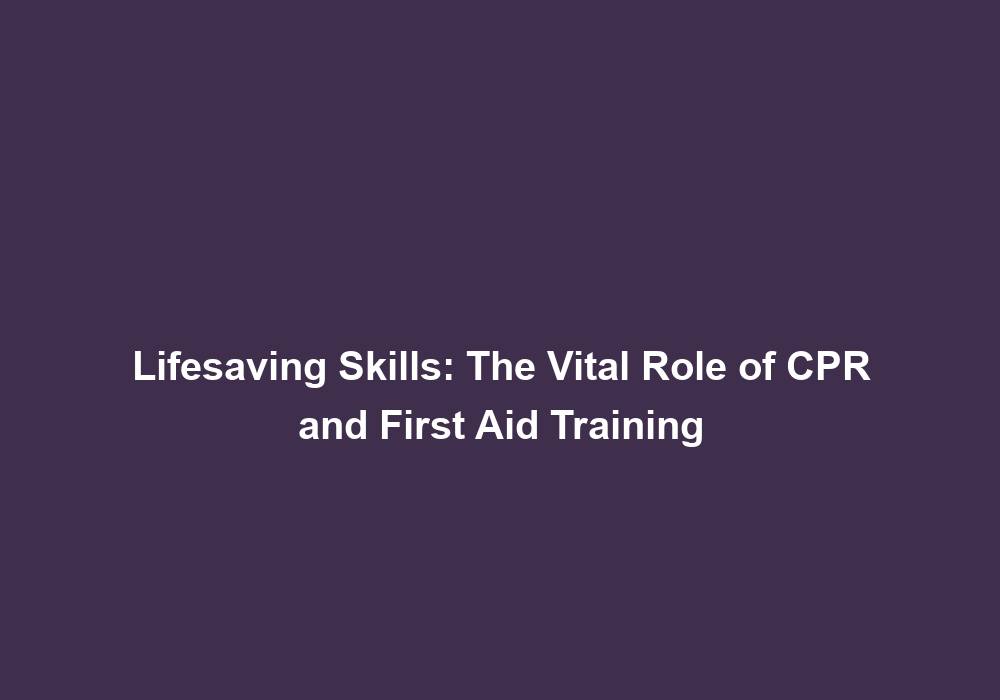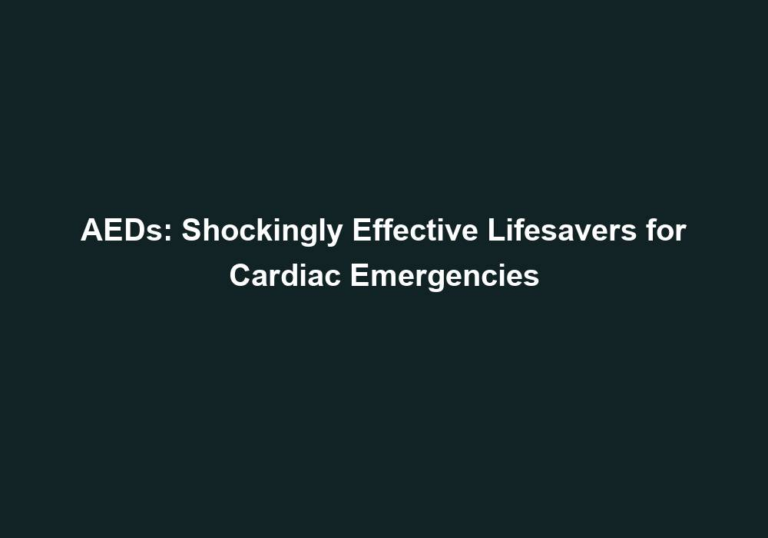Lifesaving Skills: The Vital Role of CPR and First Aid Training
In our day-to-day lives, accidents and emergencies can occur at any time and in any place. Whether it’s a sudden cardiac arrest, a choking incident, or a severe injury, being equipped with lifesaving skills can make all the difference. CPR (Cardiopulmonary Resuscitation) and First Aid training play a crucial role in providing immediate assistance to those in need, potentially saving lives before professional medical help arrives. Let’s delve into the importance of these skills and how they can empower individuals to become confident first responders.
Why CPR and First Aid Training Matters
Immediate Response in Critical Situations
Accidents or health emergencies can happen unexpectedly, leaving victims in a vulnerable and life-threatening state. By acquiring CPR and First Aid training, individuals gain the ability to respond promptly and effectively during these critical moments. The importance of immediate response cannot be overstated, as it can significantly increase the chances of survival and minimize the risk of further harm.
- Training in CPR and First Aid enables individuals to recognize emergency situations and take immediate action.
- Rapid response during critical moments can prevent the condition from worsening and save valuable time until professional medical help arrives.
- By knowing the correct techniques and procedures, individuals can provide essential care, such as clearing airways, performing CPR, and managing bleeding.
Saving Lives Before Professional Help Arrives
In many emergency situations, professional medical help may not be immediately available. CPR and First Aid training equip individuals with the knowledge and skills to provide critical care in the crucial minutes before medical professionals arrive. By performing CPR and administering basic first aid techniques, individuals can stabilize the patient’s condition, maintain blood flow, and ensure the best possible outcome.
- Immediate CPR can help restore blood circulation and oxygen supply to vital organs, increasing the chances of survival.
- First Aid training allows individuals to provide initial care, such as controlling bleeding, immobilizing fractures, and managing shock, before professional assistance arrives.
- By taking action promptly, individuals can prevent further deterioration of the patient’s condition and buy crucial time for medical help to arrive.
Reducing the Risk of Complications
When accidents or injuries occur, the initial moments are often critical for preventing further complications. By promptly applying appropriate first aid techniques, individuals can minimize the risk of infection, control bleeding, and prevent the escalation of injuries. This immediate intervention can make a significant difference in the patient’s overall recovery process and reduce the likelihood of long-term disabilities.
- Proper first aid techniques, such as cleaning and dressing wounds, can prevent infections and promote faster healing.
- By immobilizing fractures and splinting injuries, individuals can minimize pain and reduce the risk of additional damage to the affected area.
- Early intervention in medical emergencies, such as allergic reactions or asthma attacks, can help prevent severe complications and potentially save lives.
The Benefits of CPR Training
Restoring Blood Circulation
Cardiac arrests are one of the leading causes of death worldwide. During a cardiac arrest, the heart stops beating, and immediate action is crucial to restore blood circulation. CPR techniques, including chest compressions and rescue breaths, can be performed by trained individuals to manually circulate blood, delivering oxygen to vital organs and increasing the chance of survival.
- CPR involves chest compressions that help pump blood to the brain and other organs, maintaining vital functions.
- Rescue breaths provide oxygen to the lungs, ensuring that oxygen-rich blood reaches the organs.
- By combining chest compressions and rescue breaths, individuals can effectively mimic the heart’s pumping action, buying time until advanced medical help arrives.
Increasing Survival Rates
Studies have shown that the chances of survival from cardiac arrest decrease by 7-10% with every passing minute without CPR. By learning CPR, individuals become equipped to provide immediate assistance, significantly increasing the chances of survival until professional help arrives. Prompt CPR intervention can potentially double or even triple a victim’s chances of survival.
- CPR training enables individuals to recognize the signs of cardiac arrest and start CPR immediately, improving the odds of survival.
- By performing high-quality chest compressions and rescue breaths, the circulation of oxygenated blood can be maintained, preventing brain damage and organ failure.
- Immediate CPR buys time until advanced medical interventions, such as defibrillation, can be performed by professionals.
Confidence in Emergency Situations
CPR training not only imparts lifesaving skills but also instills confidence in individuals to handle emergency situations. Knowing how to assess the patient, perform CPR, and utilize automated external defibrillators (AEDs) effectively can boost confidence and reduce panic. This confidence allows individuals to take control of the situation, providing necessary care and support until advanced medical professionals take over.
- CPR training provides individuals with the knowledge and skills to respond effectively in emergency situations, reducing anxiety and panic.
- By understanding the correct techniques and procedures, individuals gain confidence in their ability to provide life-sustaining interventions.
- Training with AEDs empowers individuals to recognize cardiac arrest and use these devices to deliver electric shocks that can restore normal heart rhythm.
The Importance of First Aid Training
Managing Injuries and Illnesses
First Aid training covers a wide range of skills, including wound care, bandaging, splinting, and managing various medical conditions. By acquiring these skills, individuals can effectively manage injuries and illnesses, stabilize the patient’s condition, and prevent further harm. This immediate care can be critical, especially in situations where professional medical help may not be readily available.
- First Aid training teaches individuals how to assess and provide immediate care for various injuries, such as cuts, burns, and fractures.
- By applying appropriate techniques, such as cleaning wounds, applying pressure to control bleeding, and immobilizing injured limbs, individuals can prevent worsening of the condition.
- First Aid knowledge allows individuals to recognize the signs of medical emergencies, such as heart attacks or strokes, and provide initial care before medical professionals arrive.
Preventing Further Complications
Proper first aid techniques aim to minimize the risk of complications that may arise from injuries or medical conditions. By providing immediate care, such as cleaning and covering a wound, stabilizing fractures, or assisting with allergic reactions, individuals can prevent infections, reduce pain, and promote faster recovery. First Aid training empowers individuals to be proactive in preventing further harm to the patient.
- Immediate first aid interventions, such as cleaning and dressing wounds, help prevent infections and promote proper healing.
- By immobilizing fractures or dislocations, individuals can reduce pain and prevent additional damage to bones, muscles, and nerves.
- First Aid training equips individuals with the knowledge to recognize potential complications, such as signs of shock or internal bleeding, and take appropriate measures to minimize risks.
Enhancing Safety in the Community
First Aid training extends beyond individual benefits and contributes to creating safer communities. Trained individuals can assist in various settings, including schools, workplaces, and public spaces, where accidents and injuries are more likely to occur. By being proactive and knowledgeable, they can respond quickly, potentially saving lives, preventing further injuries, and promoting a culture of safety within their communities.
- Trained individuals can act as first responders in emergencies, providing immediate care until professional help arrives.
- By promoting First Aid training in schools and workplaces, communities can ensure a safer environment and reduce the impact of accidents and injuries.
- First Aid knowledge can be shared and utilized during community events, sports activities, or public gatherings, enhancing overall safety awareness and preparedness.
Conclusion
CPR and First Aid training are vital skills that can empower individuals to become effective first responders in emergencies. By acquiring these skills, individuals can provide immediate care, stabilize a patient’s condition, and potentially save lives. The ability to respond promptly in critical situations, reduce the risk of complications, and increase survival rates highlights the importance of widespread CPR and First Aid training. Let us all take the initiative to learn these lifesaving skills and contribute to building safer and more resilient communities.







